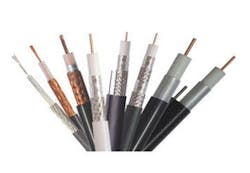Coaxial Cable Loss due to Dielectric Conduction
The coaxial cable provides a transmission line with low loss characteristics that can shield from outside signals and provide a durable yet flexible line that can be used in a variety of applications with a wide range of frequencies. At microwave frequencies, much of the loss in coaxial cable transmission lines is characterized as metal loss however, losses due to dielectric conduction can be significant for some uses.
What is dialectic conduction loss?
Electrical losses in a coaxial cable create heat in the center and outer conductors. Because most of the heat is generated at the center conductor of the cable, this heat is referred to as dielectric conduction. Dielectric conduction loss is caused when the insulating material inside the transmission line absorbs energy from the electromagnetic field developed between the inner and outer conductors. The dielectric in coaxial cable refers to materials with a high polarizability, is used to indicate the energy storing capacity of the material by means of polarization, and is expressed by a number called the relative permittivity. A coaxial cable uses the permittivity of the material between the center conductor and shield to determine its characteristic impedance when it is used as a transmission line. Dielectric insulators polarize to oppose an applied electric field which decreases the electric field in the dielectric material and reduces internal loss in the cable.
Construction and performance of coaxial cable
The coaxial cable conducts electrical signals using a solid, stranded, or copper plated steel wire, known as the center conductor or core, surrounded by an insulating layer, the dielectric, which is enclosed by a shield and protected by an outer insulating jacket. The function of the dielectric is to maintain the spacing between the shield and the center conductor but a certain amount of signal energy is dissipated in the dielectric material itself. The ideal dielectric material does not exhibit electrical conductivity when an electric field is applied however, all dielectrics have some degree of measurable conductivity.
Temperature stability is important to maintain in order to gauge and regulate the performance of the coaxial cable. If the temperature of the coaxial cable is elevated too high or too quickly, the cable may become warped and damaged beyond repair. As any heat generated due to dielectric losses is dissipated within the dielectric, it is paramount that the construction of the dielectric material be considered when selecting the correct cable for the specific application.
The most common dielectric material is polytetrafluoroethylene (PTFE) which has lower dielectric losses than PVC. The benefit of using PTFE are that this material can tolerate temperatures ranging from -50°C to +200°C and is often combined with other materials to increase dielectric constant or improve temperature stability. The drawback of this material is that it is sensitive to moisture under voltage stress.
